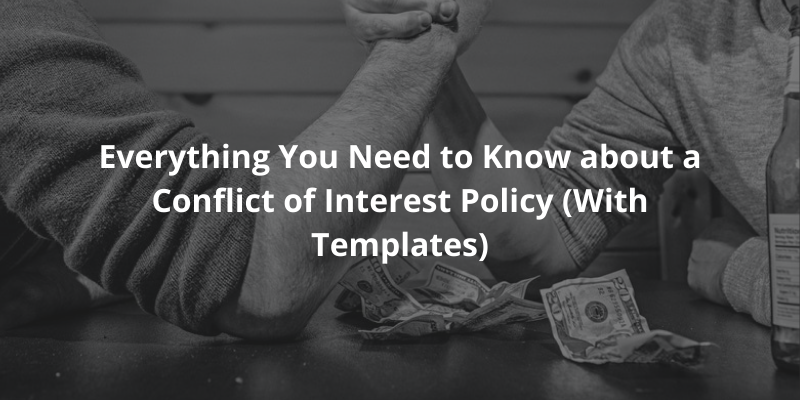Conflict of Interest Policy: A Complete Guide
31 Jan 2023
23 Apr 2021
min read

For protection and avoidance of any adverse contravention of business interests, companies and organisations should create and implement a conflict-of-interest policy. A conflict-of-interest policy governs circumstances in which employees or those working on behalf of the organisation act in a way that offends the organisation’s interests. With a well-written conflict of interest policy, any adverse action can be dealt with efficiently across the board.
Here is your complete guide to the creation of a conflict-of-interest policy. We have also created documents suitable for employment and the creation of a trust.
.jpg)
What is a Conflict of Interest Policy?
A conflict-of-interest policy is used to outline procedures in which a possible conflict might exist between the interests of individuals and the interests of the organization. This policy is commonly issue used in the workplace, business transactions, or the creation of a trust. Ideally, it should describe what constitutes a conflict of interest in that organisation. The policy should also include specific examples to help employees better understand the policy.
Conflict of Interest in the Employment context
Conflict of interest is a very broad concept. Assessment of the conflict of interest at hand is highly dependent on the facts of the case. However, the general idea is that the employee's interest should be measured against the interest of the organization. This means that different companies inevitably have very different policies. What is considered a conflict of interest in the public sector might be different from a private company; in the same vein, a non-profit organization is likely to have completely different policies from a partnership.
Assessing the employee’s conduct will also vary as they hold different responsibilities. The position and role of the employee will determine the limits of conflicts of interest. If the employee is in a highly regulated industry like banking, the threshold imposed upon an employee might be higher. Many industries also provide specific guidelines on professional ethics.
Types of conflict of interest

Generally, there are three types of conflict of interest. Different consequences may follow depending on the type of conflict of interest that arises. However, companies may choose to impose a more severe punishment notwithstanding the specific type of conflict of interest. It is important that employees are aware of the nuances and read over the policy carefully. Here are the three broad types of conflict of interest:
An actual conflict of interest
This occurs when there is a direct clash between one’s duties and responsibilities and personal interests. This clash, therefore, affects one’s performance of those duties. For example, if a company director enters a transaction with another company, that will constitute a conflict of interest, as he is also the director of the company.
Perceived conflict of interest
This occurs when an individual has two competing interest that is likely to interfere with one’s ability to fulfil the responsibilities of their job.
Potential conflict of interest
This exists where is no actual conflict of interest, but there could be one, due to their affiliation or membership elsewhere. This is when an action has not taken place, but it is nevertheless foreseeable that there will be a conflict of interest if the action is executed.
Examples of Conflicts of Interest at Work
.jpg)
1. Nepotism
This is when a person is hired purely based on certain connections than their qualifications, credentials, and competence. For example, a person who hires a family member might give that family member a bonus payment and certain privileges at the company.
2. Approaching Clients
This is when a person approaches a company’s clients without the employer's permission.
3. Breach of Confidentiality
This occurs when information about the employer is leaked in exchange for money. Although conflict of interest technically does cover a company's confidential information, in these circumstances, it would be useful to further include a non-compete and non-confidentiality clause for better protection.
4. Part-time work
This refers to situations where the employee works part-time at another company that provides goods or services that rival the place of full-time employment.
5. Relationships
This occurs when the employee has a romantic or sexual relationship with their supervisor or subordinate, resulting in the employee receiving special treatment. Dating a company client would also constitute a conflict of interest as the employee may be more prone to offer the client deals that the other clients would not receive. In doing so, the employee contravenes company interests.
6. Owning stakes in other companies
Generally, owning stakes in a competitor company constitutes a conflict of interest. This is, however, subject to the factors like the number of shares owned and annual income from that company.
7. Seizing business opportunities that your company might have otherwise pursued
This refers to circumstances in which the employee uses insider information obtained from the company for personal gain. Since this information is usually confidential, it may also put the employee in breach of their duty of confidentiality.

How can businesses prevent or reduce Conflicts-of-Interest at work?
Unfortunately, there is no one way to prevent conflicts of interest at work. This is especially the case because many situations are innocent, where employees don’t even realise that their conduct constitutes a conflict of interest.
However, with a conflict-of-interest policy, employees can be better prepared regarding what to do when these situations arise. Below are some ideas for procedures and considerations to be included:
1. Form Reporting Procedures
An organization needs to encourage employees to disclose such interests to the company. Creating a formal reporting policy enables employees to negotiate with the organization and perhaps come up with a solution that accommodates both interests.
2. Privacy
It is important to designate a suitable individual for hearing the reports about conflict of interest. This helps ensure the employee is comfortable and that there is privacy.
3. Investigation
The policy must have a deterrent effect to allow employees to understand the severity of engaging in activities contrary to the company's interests. However, the company must also be flexible as sometimes, employees genuinely do not mean to harm the company. Hence, an organisation should aim to strike a balance between these two factors. When investigating a conflict of interest, the company should look into the employee's intentions and allow them to explain themselves properly.
4. Actions
Affirmative actions must take place after the investigation to enforce the severity of the matter. Some of the sample actions that arise after an investigation may be:
-
No action taken
-
Issuance of warning letters
-
Issuance of Final warning
-
Suspension
-
Expulsion (Termination of Contract)
5. Records
All handlings should be properly recorded in writing. This will ensure that there is consistency in upholding the company’s conflict of interest policy. These records are important as they can help the company reflect upon its policy and its effectiveness.
6. Communication & Training
After investigating, the company must ensure that all stakeholders of such a conflict of interest are properly informed of the result. Training should also be undertaken – this might involve hosting interactive workshops to allow your employees to fully understand these concepts and develop a common understanding of such concepts in your organisation.
Other conflicts of interest
Fiduciary Duties
Conflict of Interest does not only arise in an employment context. It is also directly applicable to people with fiduciary duties, like company directors, who are vested with powers to control assets and decide on company strategies. This gives them room to abuse the power for their gain. In many jurisdictions, the legislation governing companies will stipulate that a director must disclose an interest that is to interfere or conflict with the organisation’s interest.
Trustees
Trustees are in a position where they manage assets on behalf of someone else for a particular purpose for the trust. An example would be where a trustee manages the administration of a charity that safeguards the wellbeing of underprivileged elderly. Conflict of interest might arise when a trustee uses these assets for their gain rather than the purposes defined in the trust document. Since in the context of charities it is an offence to not declare such an interest, charities tend to have stringent requirements. They often will require trustees of charities to submit financial reports and conduct auditing very frequently. This ensures that there is no corruption within the charity.
It gets more complicated when the trustee is also a beneficiary as there is an inherent potential conflict of interest. It is not easy to ensure that all trust beneficiaries enjoy the benefits arising out of the trust. For example, the trustee may want to sell the trust assets, but the other beneficiaries may want to retain the asset. It then becomes a complicated problem as the trustee will be in a position of causing a conflict of interest or get sued by the beneficiaries for breach of trust. Any trustees in these situations should seek help from a lawyer immediately.
Independent Contractors
This category includes business consultants, supplier service, service workers, and lawyers that you recruit on a one-off or recurring basis. While these people are not employees, they may still have an obligation to avoid activities that constitute a conflict of interest if the underlying contract contains a conflict of interest clause.
Please note that this is a general summary of the position under common law and does not constitute legal advice. As the laws of each jurisdiction may be different, you may wish to consult your lawyer.
Keywords:

